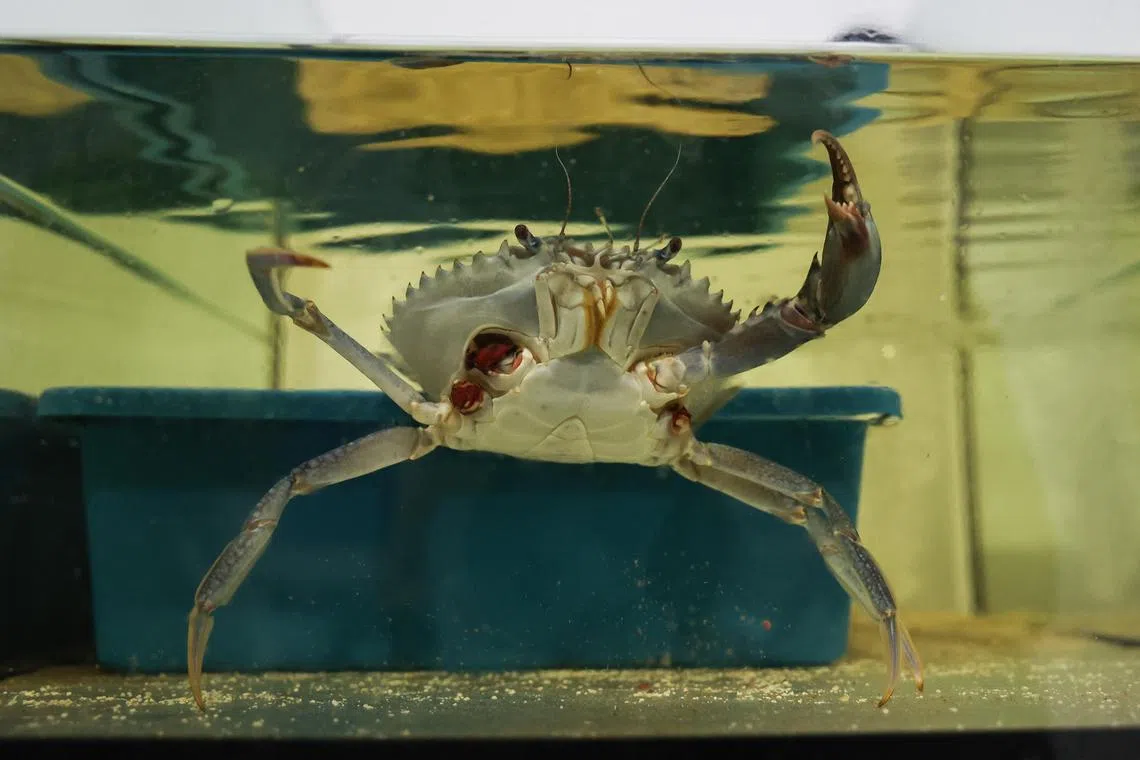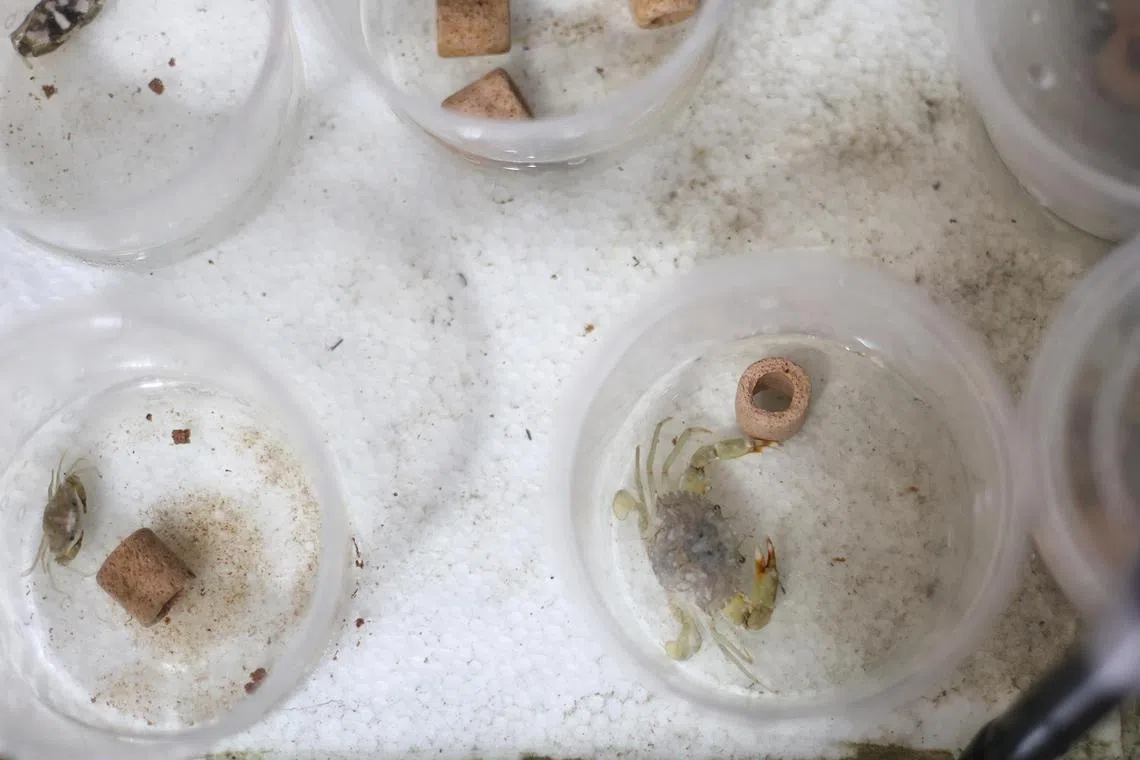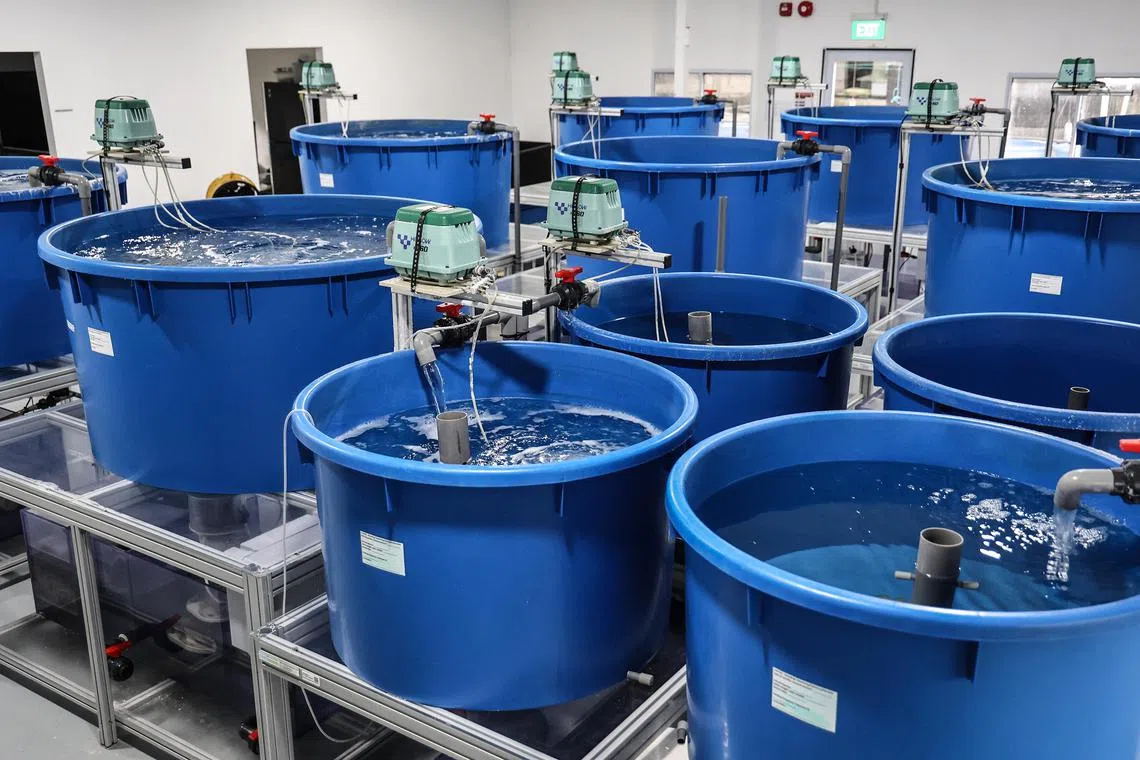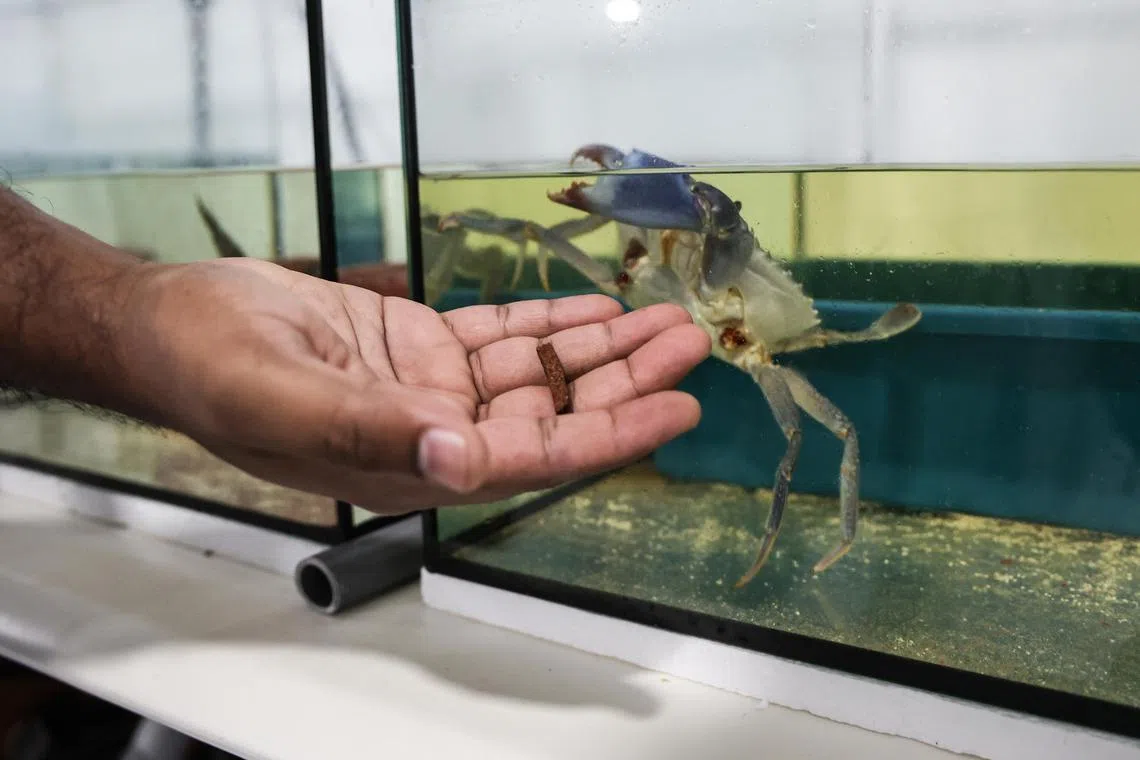Making sure the stars of chilli crab won’t vanish from the table
Sign up now: Get ST's newsletters delivered to your inbox

A mud crab in a tank at the Aquaculture Innovation Centre's research facility in Neo Tiew Crescent.
ST PHOTO: HESTER TAN
Follow topic:
SINGAPORE – Mud crab experts are on a mission to ensure that seafood lovers can continue to enjoy the delicacy for decades to come, without putting a strain on nature.
A research centre in Temasek Polytechnic (TP) is working alongside the United Nations food body and aquaculture experts in the Asia-Pacific to modernise mud crab farming, which involves breeding and hatchery-based farming among other methods.
While mud crabs are the stars of the famed Singapore dish chilli crab, the technologies and innovations behind mud crab aquaculture are still nascent compared with those for shrimp and fish, said Dr Diana Chan, deputy centre director of the Aquaculture Innovation Centre (AIC) at TP.
Between Nov 27 and 30, aquaculture experts from the region and the UN Food and Agriculture Organisation (FAO) convened at the AIC to discuss progress made in domesticating mud crabs and the challenges in raising harvests sustainably.
It was a long-awaited workshop, with the last meeting of this sort happening in 1991 when Thailand held a major international seminar on mud crab rearing and trade.
The four-day workshop in Singapore kick-started the process of updating an FAO manual on mud crab aquaculture for food authorities and farmers to use as a guide. The manual, which is expected to be finalised by end-2024, will be the second edition of the 100-page document first published by FAO in 2011.
The highly technical second edition will cover innovations and updated crab farming protocols, said Mr Alessandro Lovatelli, aquaculture officer in the FAO fisheries and aquaculture division.
“The discussions led to the formulation of recommendations that require attention from (countries’) fishery authorities to ensure that the industry grows well, sustainably and to ensure that wild resources, including mangrove forests, are exploited sustainably,” he added.
There are four species of mud crabs, including the giant mud crab, which many know as the Sri Lankan crab.
Mud crab farming worldwide largely involves taking the crustaceans from the wild and fattening them up in farms, but such capture-based aquaculture has been depleting the wild population.
Globally, just under 300,000 tonnes of mud crabs are produced for food a year and Singapore, a major mud crab importer, receives a few thousand tonnes a year.
Dr Colin Shelley, founder of mud crab consultancy Scylla who attended the workshop, said data on the wild populations of mud crabs is limited, but anecdotally, many countries are facing overfishing. The signs include a smaller pool of wild stocks and smaller average crab sizes.
Seafood importers in Singapore have for years been seeing the trickle-down effects of a less sustainable mud crab industry. Fluctuating import prices on a daily basis, with up to a few dollars’ increase for every kilogram of crabs, can be frustrating for customers and restaurants.
Price fluctuation can also be worsened by weather and political developments such as labour strikes, said Mr Jim Lee, founder of seafood wholesaler Jim Foods. For two days in the past week, his shipment from Chennai – battered by Cyclone Michaung – could not reach Singapore.
In the 1990s, medium-sized Sri Lankan and Indian crabs cost just above $10 per kg, but now the price has soared to $30 per kg, he added.
Dr Shelley stressed that there is a need to transition towards breeding and hatchery-based farming. Currently, Vietnam is leading the way in mud crab hatcheries.
At the same time, there are many farming aspects that need to be improved, starting with raising the survival rate of fertilised eggs so that they grow into crablets, added Mr Lovatelli.

Some of the crablets being reared and used for feed trials at AIC’s research facility. The mud crabs are kept in individual containers to prevent them from attacking each other, as they are cannabalistic.
ST PHOTO: HESTER TAN
“At present, a hatchery that does well will have a survival rate of anywhere between 7 and 15 per cent (of hatched eggs). We can improve considerably,” he said.
There is also a need to create more formulated feeds since farmed crabs are still mainly fed with fishmeal or “trash fish” that are not sold for human consumption, and this causes overfishing.
The AIC, formed in 2019, has been working on these challenges in its facilities at TP and an indoor research farm in Neo Tiew Crescent. The researchers have worked out the hatchery conditions, including water quality and temperature, which favour the hatching and survival of the zoea and larvae, before they morph into crablets.
To feed the crablets in nurseries, they formulated food pellets using food waste such as expired bread and spent grains, as well as the larvae of black soldier flies which are rich in chitin, the building block of crustacean shells.

Once crab eggs are hatched, the zoea are transferred to the recirculating blue tanks as part of AIC’s hatchery research.
ST PHOTO: HESTER TAN
A study they recently conducted showed that the flies’ larvae can fully replace fishmeal in food pellets with minimal changes to the crablets’ growth and shell moulting, said AIC’s Dr Chan.
Newly imported live crabs entering the Neo Tiew facility are also thoroughly screened for diseases and parasites.

A mud crab about to be fed with a food pellet.
ST PHOTO: HESTER TAN
The next steps for AIC include using genetics to breed hardier baby crabs and unlocking chitin in the concocted feed to make it more digestible for the crabs.
After the workshop, a few mud crab-producing countries approached AIC to collaborate on research, diagnosis of diseases, and training, said Dr Chan.

AIC’s senior research executive Arefin Rahman fishing a mud crab out of its tank at the centre’s research facility in Neo Tiew Crescent.
ST PHOTO: HESTER TAN
Mr Lovatelli noted that AIC has been supporting applied research that will help bring about innovations in crab farming.
And on a larger scale, Singapore can help with unlocking investments in the regional crab farming sector – by ensuring the uptake of technologies and identifying investment funds, he added.
Dr Shelley said: “The overall feeling coming out of the workshop was ‘bullish’ with regard to the future of mud crab farming.”


